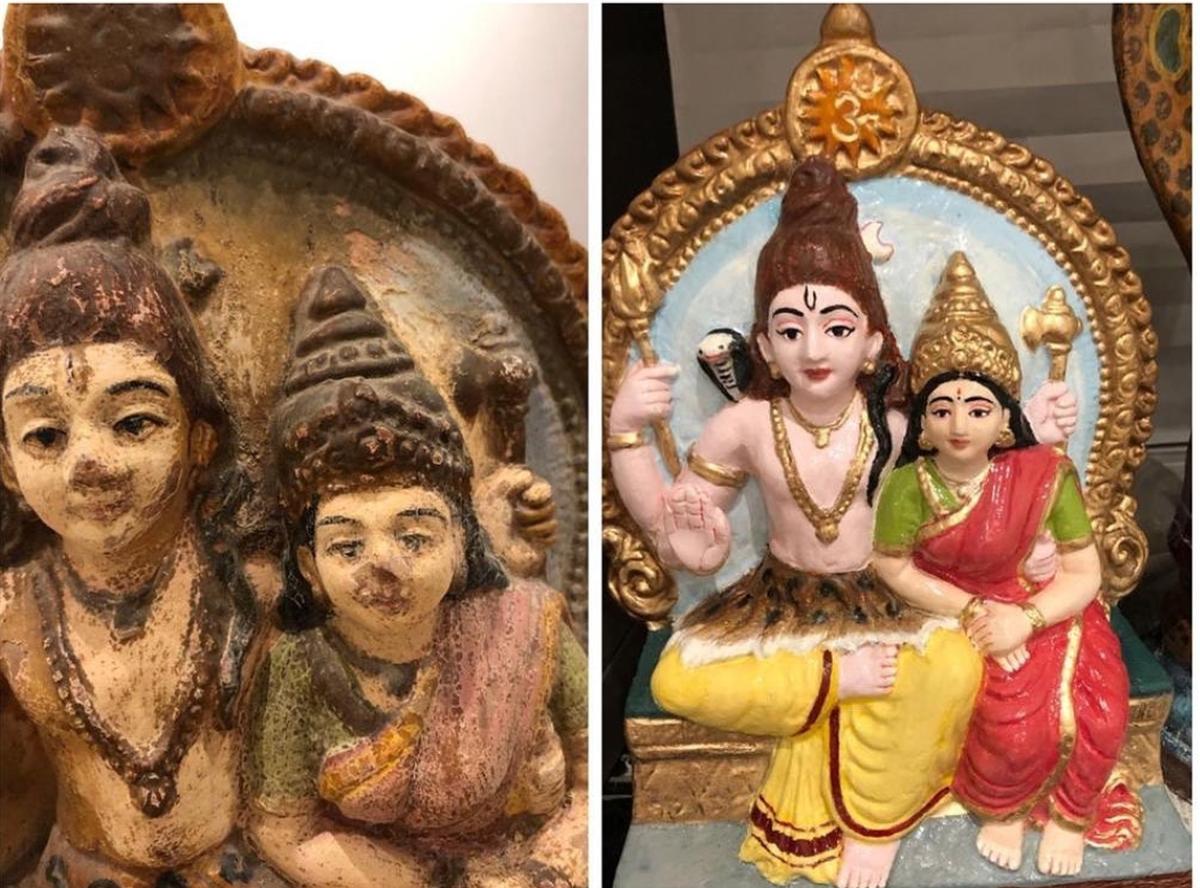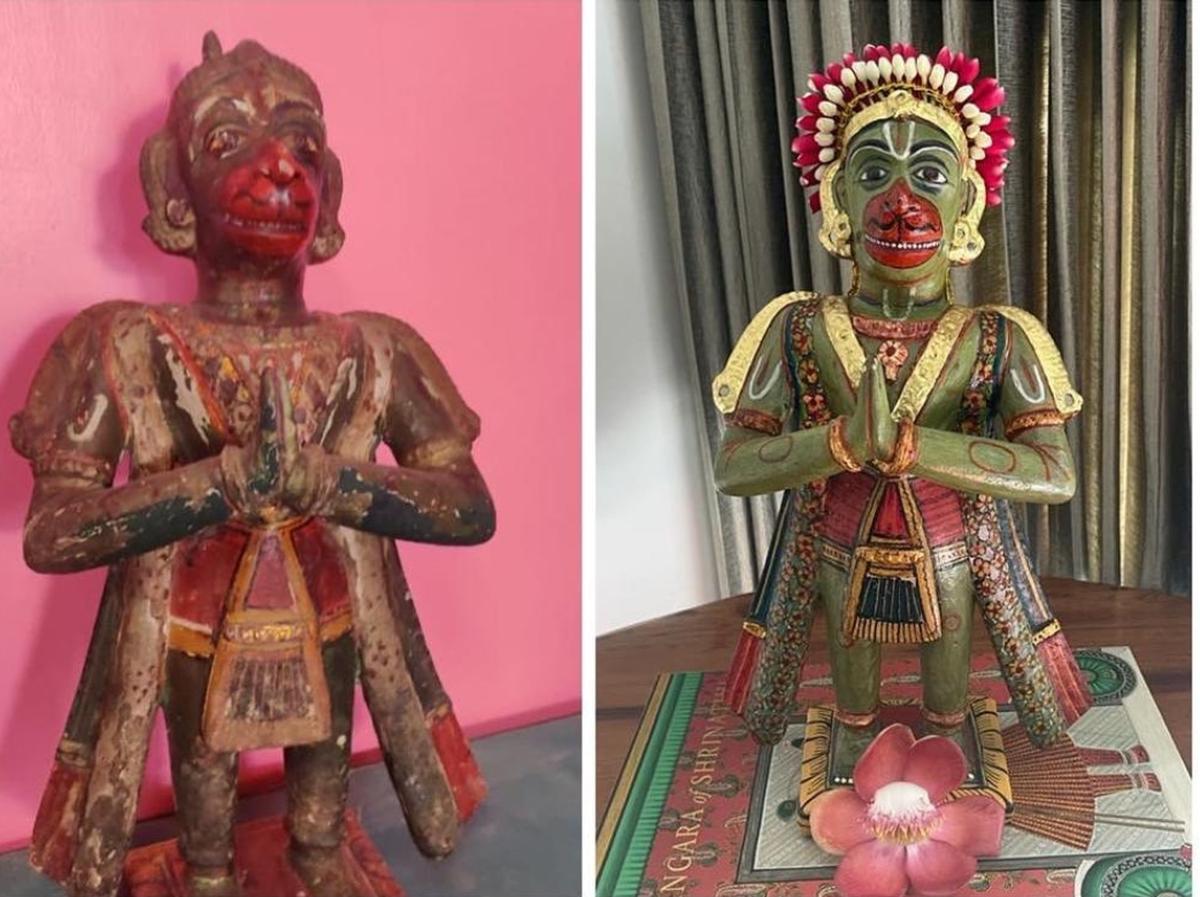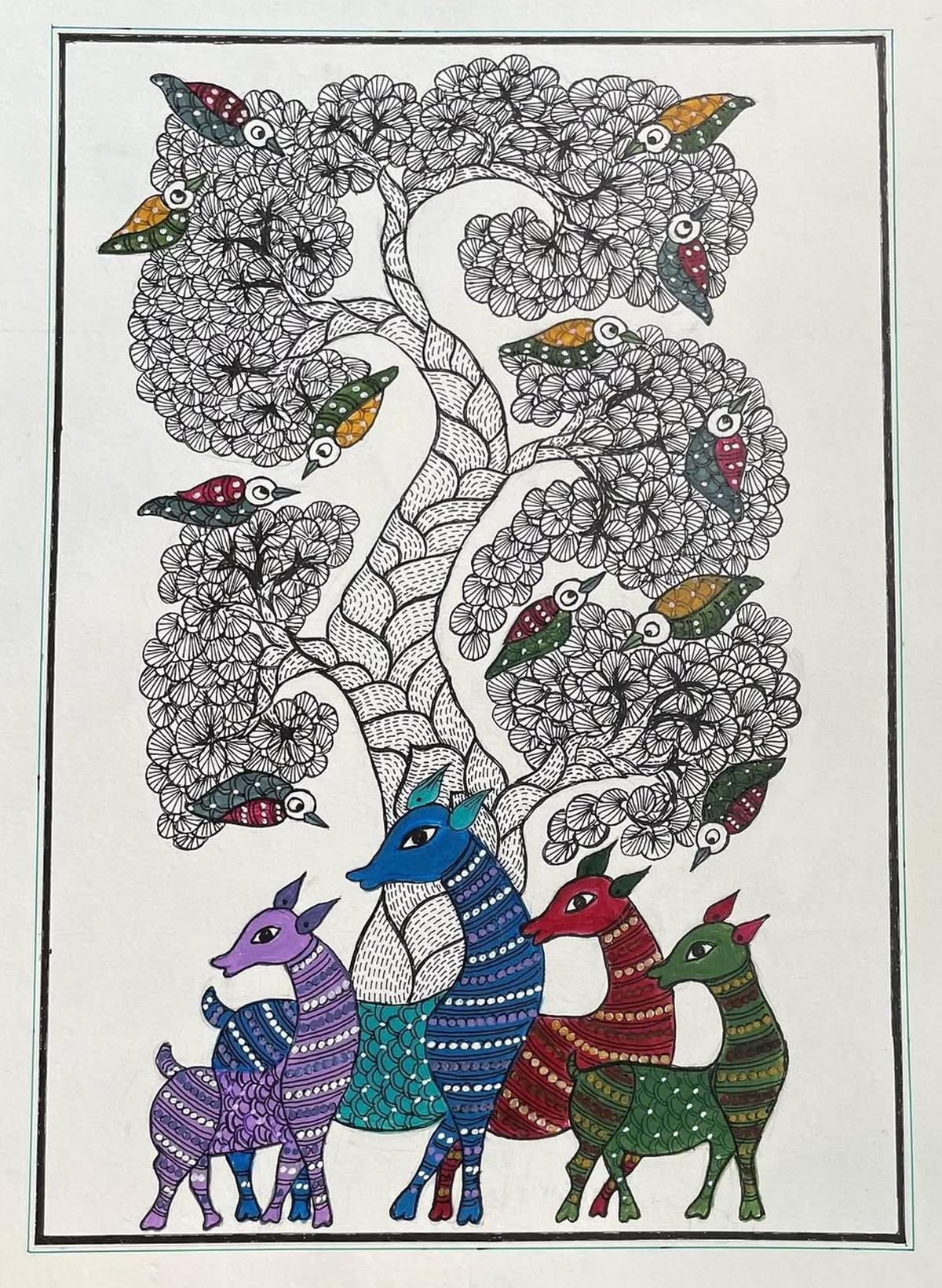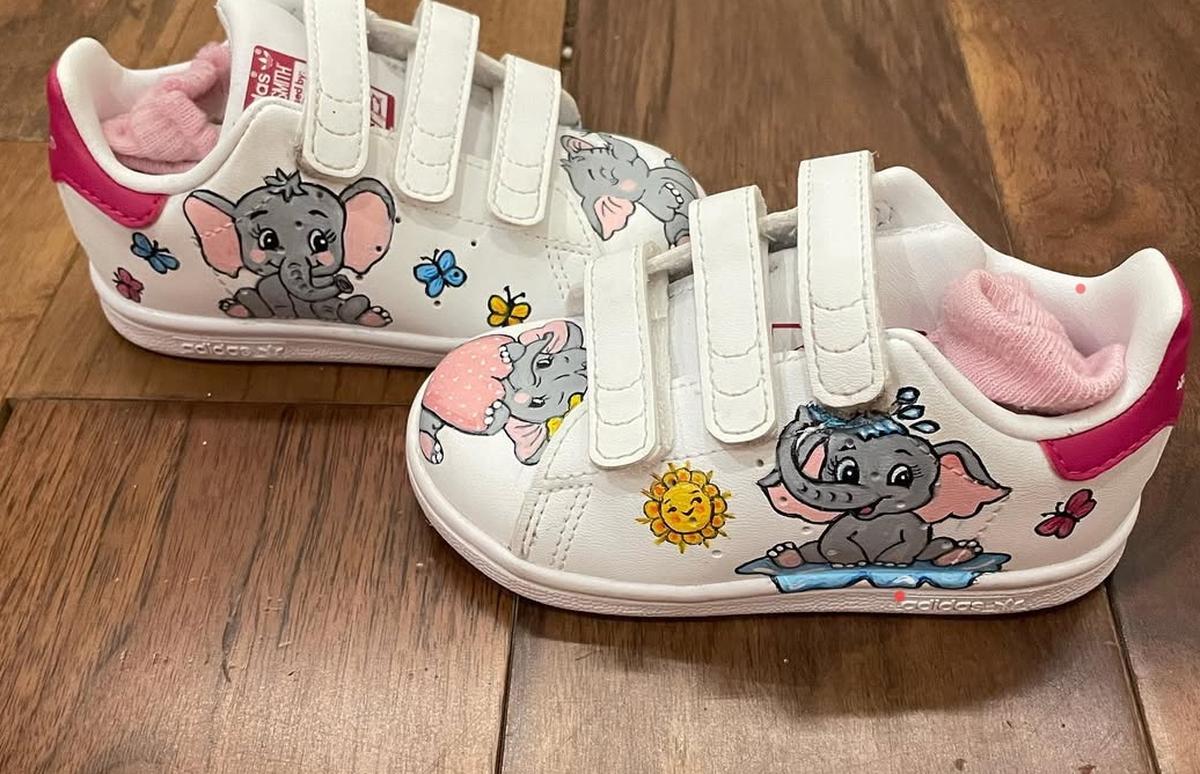Renu Sabanayagam calls erstwhile kolu dolls out of retirement, rehabilitates them and puts them back on the Navarathri beat.
Each doll in her kolu collection now can share an account of how wholesomeness was restored to it. When Renu picked them up, these dolls were lying in dingy cubbyholes and dusty antique stores, broken in body. Missing body parts had to be reconstructed and glued on to their frames, which were usually hugely lacklustre, requiring deft dabs of an enamel paint-carrying brush. Renu has made them whole again in an ongoing do-it-yourself project (est. 2018). In her own words, this project (entirely a hobby to her) has so far notched up a tally somewhere between 200 and 300 dolls, each of them restored variously.

Shivan-Parvathy kolu doll, before and after restoration.
| Photo Credit:
Special arrangement
The artist in Renu encourages her to seek those dolls that need to check into a workstation before ascending the kolu stage. Quoting Renu: “I am able to do this work only because I know how to draw and paint.” Though “Renu the artist” is germane to the topic, let us save that for the last.
The Kolu display stands out for its diversity, the dolls differing noticeably in stature and dimension.
Renu, a resident of Kesavaperumalpuram in R.A. Puram, explains: “Nothing I got, I got as a set. That is why the dolls are in disparate sizes. I think in those days they used to make the Ramayana set and all that. But nothing has been handed down to me from those days. This is not from my in-laws, this is not from my parents. This is what I have collected myself in antique shops. So, sometimes you get big dolls, sometimes small dolls.”

Murugan kolu doll before and after restoration.
| Photo Credit:
Special arrangement
A walkaround
In traditional kolu displays, the dolls sit squat on stands with multiple steps (kolu padi), resembling school students in a bleachers-style seating arrangement, every strand of hair slicked into place for a group photograph. This tiered arrangement works best when the author of the display is faced with restrictive spatial bandwidth. Renu need not skimp on space, but that is only half the reason for dispensing with the traditional display format. The other half, the more compelling one, is that her kolu tableux accommodates multiple themes, and demands (and warrants) a walkaround. The result: a “banquet” distinguished by “themed counters”, each representing a purana.
Terracotta kolu dolls that Renu restored and has now displayed in a sequential manner for her to give a commentary on Krishna avatar.
| Photo Credit:
PRINCE FREDERICK
How she put together a collection with its various themes provides a microcosmic view of the human situation, giving a peek into the weighty philosophical question of determinism versus free will. Renu’s collection seems to prove one has agency to craft their personal stories up to a point, and beyond that, those stories develop a mind of their own and unapologetically rewrite themselves, striking out entire paragraphs with the red-end of a two-coloured editor’s pencil. Putting it plainly, the drift of her kolu stories is predicated on the dolls that show up in those old antique stores, some cobwebbed.
Renu notes: “When I find this doll, then that doll, I say, okay let me have this story.” Which ancient story, and which aspect of it is thrown into relief, depends on the dolls she has gathered as well as the dolls she is willing to wait for.

Restoration of a Pavanputra hanuman doll.
| Photo Credit:
Special arrangement
An illustration from Renu: “I found these two beautiful dolls, which were Sita and Lakshmana. And for a long time, I searched for a Rama doll to match this. But no Rama doll I found came equal to the beauty of these two dolls. I could not match it. I told myself ‘Why not try something new?’ And so, I did the Lakshman Rekha part of the story.” She placed a decorative tape to signify the Lakshman Rekha with the Sita and Lakshmana dolls in the picture.
The themes she has stitched together working around the inherent limitations of her uncompromising kolu-designing philosophy include Rama avatar, Krishna avatar, Meenakshi kalyanam, Trishabha vahana, a collection of Vahanas, the story of Kannappa Nayanar from Periya Puranam, the story of Kothai becoming Andal. Towards the fag end of the walkaround, one notices a shift in focus. She has dolls demonstrating justice delivered and denied from the seat of power by Manu Nidhi Cholan and Pandya king Nedunchezhian respectively. The tour ends with with two themes, each sending out a message to the modern, largely urban consumerist soul — how ancient traditions conserved water and eschewed excess even in wedding ceremonies.
Renu has designed the kolu as a walkaround.
| Photo Credit:
PRINCE FREDERICK
Now, let us have a glimpse of the rehabilitation process. Renu works with clay and enamel paint to restore these dolls. Dexterity is an invisible ingredient. Terracotta dolls make a massive majority, coming close to constituting the entire collection. And sandblasting an old, vintage car, 10 feet long and abandoned for a hundred years is an undemanding exercise when compared with cleaning a terracotta doll that fits in between the thumb and the index finger. Porous, terracotta dolls accumulate considerable dirt. Brittle, they can give way under slightly sustained pressure. One can be certain she was breathing easy while working on a handful of wooden dolls, also on display at the kolu.

Restoration of a doll depicting “Churning the Milky Ocean”.
| Photo Credit:
Special arrangement
Renu has been collecting and restoring kolu dolls since 2018, adopting the hobby to fill a void created by an empty nest, the children leaving home in pursuit of their own destinies. Renu notes in all these years only around a couple of dolls came painted in natural pigment colours; the rest arrived with enamel paint in various stages of flaking. In many a case, she has had to recreate entire features with the paint brush, and restore the doll’s essential patina. Renu the artist is intrinsic to this collection. She observes that when she saw two dolls, both based on Ravi Varma’s paintings, she knew the creative source.
The artist
Renu calls herself “a largely self-taught artist” and “an amateur artist” (which comes across as a modest self-assessment when one gets acquainted with her work) who “works with different art forms”. One senses a particular liking for Gond tribal art. She does not always work with paper and canvas, occasionally with white shoes too — “shoes” here is not an auto-correct error.

An artwork set in the mould of Gond tribal art.
| Photo Credit:
Special Arrangement
Her husband Rajendran Sabanayagam (who was with McKinsey & Company in New York and on return to India founded Sumangala Steel) explains: “Her artistic abilities were developed under the informal tutelage of my mother, Savithri Sabanayagam, and while travelling with me both in India and abroad. The artworks are of professional quality, everyone who sees them say that, but she does not want to leave her comfort zone and keeps it within the family.” Which means giving her artworks to relatives, and also adding artistic value to white shoes bought for children in the family (she has three grandchildren) as well as those in the extended family.

Artwork done on the shoes for a granddaughter
| Photo Credit:
Special arrangement
Says Rajendran: “She gets shoes, white shoes. And she paints on the white shoes for all the children. I have given her one of my white shoes and I have asked her to paint it for me.”
That would likely be the immediate project following this kolu season — Rajendran hopes it is.
Published – September 27, 2025 10:47 am IST